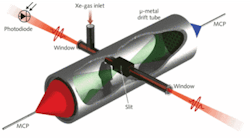Zinc oxide (ZnO) is an alternative to gallium nitride (GaN) as a UV-emitting semiconductor, but it is more difficult to make into lasers. While a GaN laser normally takes the form of the conventional electrically pumped cleaved-crystal diode, ZnO lasers are unconventional–optically pumped random-lasing disordered particles, optically pumped nanowires, electrically pumped random-lasing heterojunction diodes, and others. A ZnO laser developed by researchers at the University of California at Riverside, while still lasing randomly, is a bit more like conventional laser diodes in that it is based on a p-n junction, electrically pumped, and is a quantum-well device.1 It is a step toward the creation of practical ZnO lasers.
The laser structure was grown on a silicon (Si) substrate via molecular-beam epitaxy. After depositing a thin layer of magnesium oxide to reduce the lattice mismatch between Si and ZnO, and then a 15 nm ZnO buffer layer, the researchers fabricated a ZnO p-n junction structure (gallium doping for n, and antimony doping for p) with a thickness of 340 nm for both the n and p layers. Between the n and p layers, a 1 nm layer of magnesium-containing ZnO was deposited, forming a quantum well. Square mesa diodes 500 × 500 µm in size were formed via optical lithography and etching, and electrical contacts deposited.
The ZnO diode film takes the form of closely packed columnar structures 100 to 400 nm in width (see figure). The lasing is induced by interactions between excitons (electron-hole pairs).
Under a low continuous injection current of 10 mA, the structure spontaneously emitted weak broadband light centered at about 380 nm. When the injection current was increased to 20 mA the device lased, producing a single narrow (0.4 nm) line. Boosting the current to 60 mA increased the number of lasing mode peaks to 20 or so, all falling within a spectral band of about 20 nm, and resulting in an optical output power of 0.5 µW. Further current increases produced 1.4 µW of optical output at 80 mA and 11.3 µW at 130 mA.
Closed-loop scattering
Because the nanocolumns are only about 700 nm long, they do not have enough gain to act as Fabry-Perot cavities to form conventional resonant laser cavities. A second form of lasing based on polaritons was also ruled out, because there was no evidence of the existence of polaritons. The researchers determined that lasing occurs due to scattering of generated light off the nanocolumns, forming closed-loop resonant cavities; in fact, they could see the closed-loop cavities under the microscope as isolated lasing spots. As is the case with other random lasers, the light is emitted in a wide cone (in this case, with a half-angle of 60°).
Jianlin Liu, one of the researchers, notes that the in situ p-type doped ZnO layer, which is a feature that no previous ZnO random lasers had, will result in superior efficiency and reliability. He sees applications for these types of lasers in biological and chemical agent detection, molecule photofragmentation, object color marking, water purification, laser-based weapons, wireless UV communication, and others. “We are working on highly directional and coherent ZnO lasers that operate in a nonrandom manner,” he adds.
REFERENCE
- S. Chu et al., Appl. Phys. Lett. 93, 181106 (Nov. 3, 2008).

